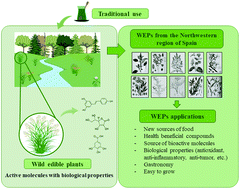Culinary and nutritional value of edible wild plants from northern Spain rich in phenolic compounds with potential health benefits
Abstract
Wild edible plants (WEPs) have been consumed since ancient times. They are considered as non-domesticated plants that grow spontaneously in nature, particularly in forests and bushlands, where they can be found and collected to be incorporated into human nutrition. Increasingly, WEPs are gaining importance as they are potential sources of food due to their nutritional value, besides showing positive health effects and offer innovative applications in haute cuisine. As these autochthonous plants grow naturally in the environment, they are more suitable to adapt to different climatic conditions as well as biotic and abiotic factors. Therefore, a door has been opened for their possible cultivation as they seem to require fewer expenses than other commercially cultivated plants. Moreover, the consumers demand for new products of natural origin that are sustainable and ecologically labeled have also boosted WEPs’ recovery and incorporation into the market. In addition, they are considered as promising sources of essential compounds needed not only in human diet including carbohydrates, proteins, and lipids but also of other minor compounds as phenols, vitamins, or carotenoids that have shown numerous beneficial bioactivities such as antioxidants, anti-inflammatory, or anti-tumor activity. The use of these plants rich in bioactive molecules could be beneficial from the health point of view as the human body is not always capable of producing enough defenses, for instance, preventing oxidative damage. In particular, the presence of phenolic compounds in these vegetal matrices is supposed to provide a prophylactic effect against further pathogenesis and disorders related to aging or oxidative stresses. Regarding all this information based on traditional knowledge and ethnobotanical data, different WEPs found in the Northwestern region of Spain were selected, namely, Mentha suaveolens, Glechoma hederacea, Prunus spinosa, Apium nodiflorum, Artemisia absinthium, Silybum marianum, Picris hieracioides, Portulaca oleracea, Crithmum maritimum, and the genus Amaranthus. However, even though tradition and popular knowledge are excellent tools for the exploitation of these plants, it is necessary to develop regulations in this aspect to assure safety and veracity of food products. This article aims to review the main aspects of their bioactive properties, their traditional use, and the possibility of their incorporation into the market as new functional foods, looking at innovative and healthy gastronomic applications.



 Please wait while we load your content...
Please wait while we load your content...